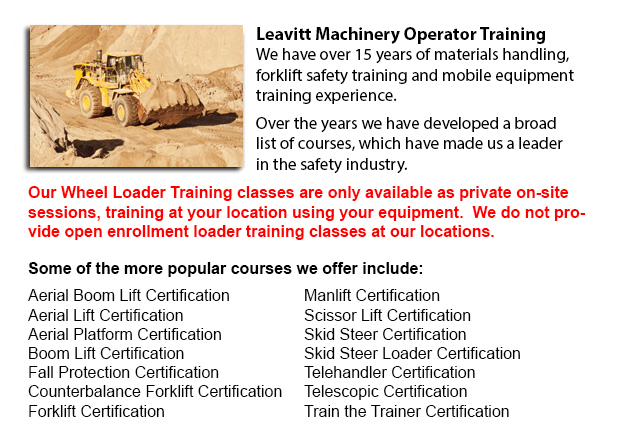
Prince George Wheel Loader Operator Training - To be able to pick up substantial loads, industrial cranes make use of levers and pulleys. In the past, Romans used cranes so as to raise huge monuments making the origin of these machinery at least two thousand years ago. Several Medieval churches utilized cranes in their construction and the Egyptians may have relied on them when constructing the pyramids.
Modern cranes could either be simple or complex, based upon the nature of the function they can carry out. For example, mobile cranes are quite simple models. A steel truss and even a telescopic boom mounts its movable platform. A system of levers or pulleys lifts the boom and there is often a hook hanging. These cranes are frequently intended for earthmoving or demolition by changing the hook out with one more piece of device like for instance a wrecking ball or a bucket. Telescopic cranes have a series of hydraulic tubes which fit together to form the boom. These units can even be mobile.
Standard wheels, or certain wheels designed for a railroad track or caterpillar track allow these mobile booms to be able to navigate uneven and unpaved surfaces.
Rough terrain and truck mounted cranes are mobile too. Outriggers are situated on the truck mounted unit to enhance stability, while rough terrain cranes consist of a base that tends to resemble the bottom of a 4-wheel drive. These cranes are outfitted in order to function on uneven surface making them ideal in the construction trade for example.
Usually utilized on ports and in railroads, the Gantry crane can move and unload big containers off trains and ships. Their bases have huge crossbeams that run on rails in order to raise containers from one place to another. A portainer is a unique kind of gantry that moves supplies onto and off of ships specifically.
Floating cranes are mounted on pontoons or barges and are one more vital piece of equipment vital to the shipping business. Because they are places in water, they are intended for different services consisting of port construction, building bridges and salvaging ships. Floating cranes are capable of handling really heavy loads and containers and similar to portainers, they could likewise unload ships.
Loader cranes are fit onto trailers utilizing hydraulic powered booms to load merchandise onto a trailer. If not being used, the jointed sections of the boom can be folded down. This type of crane could be also considered telescopic since one section of the boom could telescope for more versatility.
Usually seen in automated warehouses, stacker cranes tend to follow an automatic retrieval system and could function using a remote. These cranes are outfitted with a lift truck machinery and could be found in big automated freezers, stacking or obtaining food. Utilizing this particular type of system enables workers to remain out of that freezing environment.
Tower cranes, normally the tallest type, usually do not have a movable base. They have to be assembled part by part. Their base is like a long ladder with the boom at right angles to the base. These cranes specialize in the construction of tall structures and are often connected to the inside of the building itself all through the construction period.
-
Prince George Telehandler Operator Training
Prince George Telehandler Operator Training - Telehandler forklifts or Telescopic Handler forklifts are common industrial machines found in various construction industry settings. The telehandler is a useful machinery and makes for a valuable tool wh... More -
Skid Steer Loader Certification in Prince George
The engine powered skid-steer loader comprises a small and rigid frame, equipped with lift arms that could attach to many industrial attachments and tools to execute several labor saving tasks. Normally, skid-steer loaders are four-wheel drive vehicl... More -
Prince George Telehandler License
Prince George Telehandler License - The telescopic handler or telehandler is a generally utilized machine in agricultural and industrial applications. This machine is the same in look to a forklift and also works in a similar manner, although telehan... More -
Prince George Manlift Ticket
Prince George Manlift Ticket - The Elevated Platforms and Manlifts Certification course helps to provide the needed training on the work practices, safe operating procedures, rules and regulations regarding the everyday activities for the operators o... More -
Prince George Manlift Operator Training
Prince George Manlift Operator Training - A specialized kind of hydraulic platform is referred to as an aerial lift or a man lift. It is designed to hoist an individual vertically up and down and thus, is likewise called a vertical personnel lift. Th... More -
Prince George Forklift Safety Training
Prince George Forklift Safety Training - Individuals wanting work in industries that utilize forklifts have to undergo a forklift safety training course prior to becoming a certified operator of a lift truck. There are many ways to go about obtaining... More -
Prince George Boom Lift Certification
Prince George Boom Lift Certification - The use o elevated work platforms allow for maintenance operations and work to be performed at elevated work heights which were otherwise unreachable. Workers making use of boom lifts and scissor lifts could be... More -
Prince George Crane Training Schools
Prince George Crane Training Schools - We have designed various programs for Mobile Crane Operation at our Crane Training Schools. These programs are recommended for the skilled operator who needs certification or re-certification, and for inexperien... More

Forklift Certification Prince George
TOLL FREE: 1-888-254-6157
Prince George, British Columbia
forkliftcertificationprincegeorge.com
Email Us
About Us


